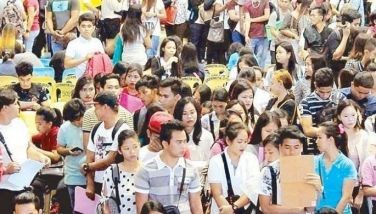Development of the Pacific Coast (The solution to the problems of Metro Manila)
December 1, 2003 | 12:00am
Beth Day Romulo herself queries, "How can this sprawling megalopolis provide living and jobs and sheer space for its gallopping population? (sixty persons are added every hour in Manila through births and migration compared to nine in the five boroughs of New York City)." She correctly observes that the first plan for the City of Manila, designed by American architect Daniel Burnham in 1905, was created for a population of 800,000 people. Yet, by the year 2000, Metro Manila had already hosted 14 million citizens daytime and 10 million at night. Ms. Romulo additionally keenly notes that Metro Manila is one of the world’s largest megacities. Although it covers only two percent of the country’s land its houses thirteen percent of its population and contributes thirty one percent of the Philippine’s national production. It is projected that by the year 2020, Metro Manila will have a mea-population of 20 million people.
Even now, the continuing question as Beth Day Romulo herself asks is: How does one make such a monstrous city liveable and globally competitive?
The plain truth of the matter is that Metro Manila, with its limited space and resources, is breaking at the seams hardput to provide a decent quality of life to the mass of its fourteen million current population. Indeed, the problems of megalopolis Manila are enormous.
Already its road network is suffering from overcapacity and overuse. With the ever mounting overpopulation, basic public utilities such as water, power, mass transportation and waste disposal are severely compromised and overburdened. Presently, certain areas have become waterless. Power delivery is strained to its limits with the bulk of the squatter colonies getting their electricity through illegal connections. Traffic is ever a major concern and problem despite the on-going construction of a mass railway transit system. The problem of waste disposal is of no small concern. As early as 1998, the daily waste generation of Metro Manila was more than 6,000 tons of garbage. Of this figure, only 4,500 tons of garbage were being collected. The rest, particularly those from the squatter areas, were either illegally dumped in vacant lots or thrown into creeks and rivers such as the Pasig river, and polluting the waterways. The garbage problem stinks to high heavens.
Due to the lack of an adequate drainage system, the poor maintenance of roads and the exacerbation of the squatter colonies, residents of Metro Manila experience the fiercest of floods. They are bound to live through bigger floods especially for those living in low-lying areas such as Malabon, Navotas, Sampaloc and Caloocan.
The growth of the urban population has exceeded government’s capacity to provide adequate housing. Thus, shanties or "barong-barongs" dot whatever space is available. The shanties sprout on public lands and even vacant titled lands of private individuals and entities. Squatter communities abound, their shacks a tangible symbol of their utter deprivation and poverty.
As naturally, the squatter colonies become the breeding places for criminality. The squatters, most of them unemployed, find no moral compunction and are easy recruits to the world of crime syndicates such as gambling, drugs, kidnapping, robberies and prostitution. There is a total breakdown of morals.
The subhuman conditions in the blighted communities are likewise breeding places for diseases. Especially during times of flood, water-borne illnesses such as cholera, diarrhea and typhoid fever abound. The poor quality of air in Metro Manila, brought about by vehicle and industrial pollutants, contributes largely to the respiratory illness of its inhabitants. Metro Manila is not a healthy place to live in.
Still, many of our brothers and sisters in the countryside continue to flock to Metro Manila, hoping to find employment here only to be met with a worse fate than they had in the provinces.
This madness simply has to come to a stop. Is there a solution to the multifarious problems of Metro Manila? Architect Palafox says that there is. The Philippines, he concludes in his paper before the Harvard Graduate School of Design, has simply not taken advantage of its wonderfully strategic location. We have over-concentrated development in the western portion of our country, such as in Metro Manila. The country has one of the longest coastlines in the world, yet has no port on its Pacific or eastern side. Palafox vigorously argues the creation of new gateways in the Pacific. The growth of the Eastern Luzon Seaboard is the alternative site and answer to the problems of Metro Manila.
Fortunately for the country, there is already an existing project, on a contiguous land area of about 80,000 hectares facing the Pacific Ocean and only 60 kilometers from Metro Manila, that presents itself as the answer to the problem of Metro Manila and could very well be a model for urban planning and a model as well for financing development. Our ensuing articles will introduce to the public this master-planned development called the "Pacific Coast Cities."
You may write your comments / suggestion at 15/F Equitable Bank Tower Paseo de Roxas, Makati City or through e-mail at HYPERLINK "mailto:[email protected]"
(Editor’s note: Atty. Roxas is writing a limited series of articles dealing with financial matters and other important business topics. He is available for speaking engagements on the subject matters of his articles.)
BrandSpace Articles
<
>
- Latest
- Trending
Trending
Latest
Trending
Latest
Recommended

























